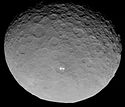Asteroid belt

The asteroid belt is a torus-shaped region in the Solar System, centered on the Sun and roughly spanning the space between the orbits of the planets Jupiter and Mars. It contains a great many solid, irregularly shaped bodies called asteroids or minor planets. The identified objects are of many sizes, but much smaller than planets, and, on average, are about one million kilometers (or six hundred thousand miles) apart. This asteroid belt is also called the main asteroid belt or main belt to distinguish it from other asteroid populations in the Solar System.[1]
The asteroid belt is the smallest and innermost known
Ceres, the only object in the asteroid belt large enough to be a dwarf planet, is about 950 km in diameter, whereas Vesta, Pallas, and Hygiea have mean diameters less than 600 km.[3][4][5][6] The remaining bodies range down to the size of a dust particle. The asteroid material is so thinly distributed that numerous uncrewed spacecraft have traversed it without incident.[7] Nonetheless, collisions between large asteroids occur and can produce an asteroid family, whose members have similar orbital characteristics and compositions. Individual asteroids within the belt are categorized by their spectra, with most falling into three basic groups: carbonaceous (C-type), silicate (S-type), and metal-rich (M-type).
The asteroid belt formed from the primordial
History of observation

In 1596, Johannes Kepler wrote, "Between Mars and Jupiter, I place a planet," in his Mysterium Cosmographicum, stating his prediction that a planet would be found there.[13] While analyzing Tycho Brahe's data, Kepler thought that too large a gap existed between the orbits of Mars and Jupiter to fit Kepler's then-current model of where planetary orbits should be found.[14]
In an anonymous footnote to his 1766 translation of

On January 1, 1801,
About 15 months later, Heinrich Olbers, a member of the celestial police, discovered a second object in the same region, Pallas. Unlike the other known planets, Ceres and Pallas remained points of light even under the highest telescope magnifications instead of resolving into discs. Apart from their rapid movement, they appeared indistinguishable from stars.[22]
Accordingly, in 1802, William Herschel suggested they be placed into a separate category, named "asteroids", after the
Neither the appellation of planets nor that of comets can with any propriety of language be given to these two stars ... They resemble small stars so much as hardly to be distinguished from them. From this, their asteroidal appearance, if I take my name, and call them Asteroids; reserving for myself, however, the liberty of changing that name, if another, more expressive of their nature, should occur.
By 1807, further investigation revealed two new objects in the region:
Despite Herschel's coinage, for several decades it remained common practice to refer to these objects as planets[15] and to prefix their names with numbers representing their sequence of discovery: 1 Ceres, 2 Pallas, 3 Juno, 4 Vesta. In 1845, though, astronomers detected a fifth object (5 Astraea) and, shortly thereafter, new objects were found at an accelerating rate. Counting them among the planets became increasingly cumbersome. Eventually, they were dropped from the planet list (as first suggested by Alexander von Humboldt in the early 1850s) and Herschel's coinage, "asteroids", gradually came into common use.[15]
The discovery of Neptune in 1846 led to the discrediting of the Titius–Bode law in the eyes of scientists because its orbit was nowhere near the predicted position. To date, no scientific explanation for the law has been given, and astronomers' consensus regards it as a coincidence.[27]

The expression "asteroid belt" came into use in the early 1850s, although pinpointing who coined the term is difficult. The first English use seems to be in the 1850 translation (by
Over 100 asteroids had been located by mid-1868, and in 1891, the introduction of astrophotography by Max Wolf accelerated the rate of discovery still further.[31] A total of 1,000 asteroids had been found by 1921,[32] 10,000 by 1981,[33] and 100,000 by 2000.[34] Modern asteroid survey systems now use automated means to locate new minor planets in ever-increasing numbers.
On 22 January 2014, European Space Agency (ESA) scientists reported the detection, for the first definitive time, of water vapor on Ceres, the largest object in the asteroid belt.[35] The detection was made by using the far-infrared abilities of the Herschel Space Observatory.[36] The finding was unexpected because comets, not asteroids, are typically considered to "sprout jets and plumes". According to one of the scientists, "The lines are becoming more and more blurred between comets and asteroids".[36]
Origin
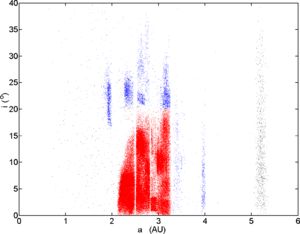
Formation
In 1802, shortly after discovering Pallas, Olbers suggested to Herschel that Ceres and Pallas were fragments of a much larger planet that once occupied the Mars–Jupiter region, with this planet having suffered an internal explosion or a cometary impact many million years before,[37] while Odesan astronomer K. N. Savchenko suggested that Ceres, Pallas, Juno, and Vesta were escaped moons rather than fragments of the exploded planet.[38] The large amount of energy required to destroy a planet, combined with the belt's low combined mass, which is only about 4% of the mass of Earth's Moon,[3] does not support these hypotheses. Further, the significant chemical differences between the asteroids become difficult to explain if they come from the same planet.[39]
A modern hypothesis for the asteroid belt's creation relates to how, in general for the Solar System,
Planetesimals within the region that would become the asteroid belt were strongly perturbed by Jupiter's gravity.[42] Orbital resonances occurred where the orbital period of an object in the belt formed an integer fraction of the orbital period of Jupiter, perturbing the object into a different orbit; the region lying between the orbits of Mars and Jupiter contains many such orbital resonances. As Jupiter migrated inward following its formation, these resonances would have swept across the asteroid belt, dynamically exciting the region's population and increasing their velocities relative to each other.[43] In regions where the average velocity of the collisions was too high, the shattering of planetesimals tended to dominate over accretion,[44] preventing the formation of a planet. Instead, they continued to orbit the Sun as before, occasionally colliding.[42]
During the early history of the Solar System, the asteroids melted to some degree, allowing elements within them to be partially or completely differentiated by mass. Some of the progenitor bodies may even have undergone periods of explosive volcanism and formed magma oceans. Because of the relatively small size of the bodies, though, the period of melting was necessarily brief compared to the much larger planets, and had generally ended about 4.5 billion years ago, in the first tens of millions of years of formation.[45] In August 2007, a study of zircon crystals in an Antarctic meteorite believed to have originated from Vesta suggested that it, and by extension the rest of the asteroid belt, had formed rather quickly, within 10 million years of the Solar System's origin.[46]
Evolution

The asteroids are not pristine samples of the primordial Solar System. They have undergone considerable evolution since their formation, including internal heating (in the first few tens of millions of years), surface melting from impacts,
The current asteroid belt is believed to contain only a small fraction of the mass of the primordial belt. Computer simulations suggest that the original asteroid belt may have contained mass equivalent to the Earth's.[53] Primarily because of gravitational perturbations, most of the material was ejected from the belt within about 1 million years of formation, leaving behind less than 0.1% of the original mass.[42] Since its formation, the size distribution of the asteroid belt has remained relatively stable; no significant increase or decrease in the typical dimensions of the main-belt asteroids has occurred.[54]
The 4:1
When the asteroid belt was first formed, the temperatures at a distance of 2.7 AU from the Sun formed a "snow line" below the freezing point of water. Planetesimals formed beyond this radius were able to accumulate ice.[57][58] In 2006, a population of
The outer asteroid belt appears to include a few objects that may have arrived there during the last few hundred years, the list includes (457175) 2008 GO98 also known as 362P.[60]
Characteristics
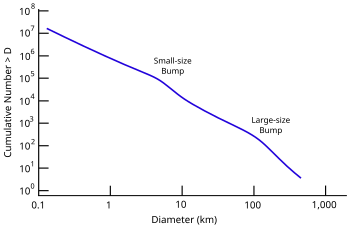
Contrary to popular imagery, the asteroid belt is mostly empty. The asteroids are spread over such a large volume that reaching an asteroid without aiming carefully would be improbable. Nonetheless, hundreds of thousands of asteroids are currently known, and the total number ranges in the millions or more, depending on the lower size cutoff. Over 200 asteroids are known to be larger than 100 km,[62] and a survey in the infrared wavelengths has shown that the asteroid belt has between 700,000 and 1.7 million asteroids with a diameter of 1 km or more.[63]
The number of asteroids in the main belt steadily increases with decreasing size. Although the size distribution generally follows a power law, there are 'bumps' in the curve at about 5 km and 100 km, where more asteroids than expected from such a curve are found. Most asteroids larger than approximately 120 km in diameter are primordial, having survived from the accretion epoch, whereas most smaller asteroids are products of fragmentation of primordial asteroids. The primordial population of the main belt was probably 200 times what it is today.[64][65]
The absolute magnitudes of most of the known asteroids are between 11 and 19, with the median at about 16.[66] On average the distance between the asteroids is about 965,600 km (600,000 mi),[67][68] although this varies among asteroid families and smaller undetected asteroids might be even closer. The total mass of the asteroid belt is estimated to be 2.39×1021 kg, which is just 3% of the mass of the Moon.[2] The four largest objects, Ceres, Vesta, Pallas, and Hygiea, contain an estimated 62% of the belt's total mass, with 39% accounted for by Ceres alone.[69][5]
Composition

The present day belt consists primarily of three categories of asteroids: C-type carbonaceous asteroids, S-type silicate asteroids, and a hybrid group of X-type asteroids. The latter[clarification needed] have featureless spectra, but they can be divided into three groups based on reflectivity, yielding the M-type metallic, P-type primitive, and E-type enstatite asteroids. Additional types have been found that do not fit within these primary classes. There is a compositional trend of asteroid types by increasing distance from the Sun, in the order of S, C, P, and the spectrally-featureless D-types.[71]
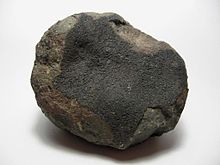
Carbonaceous asteroids, as their name suggests, are carbon-rich. They dominate the asteroid belt's outer regions,[72] and are rare in the inner belt.[71] Together they comprise over 75% of the visible asteroids. They are redder in hue than the other asteroids and have a very low albedo. Their surface compositions are similar to carbonaceous chondrite meteorites. Chemically, their spectra match the primordial composition of the early Solar System, with the lighter elements and volatiles removed.[73]
S-type (silicate-rich) asteroids are more common toward the inner region of the belt, within 2.5 AU of the Sun.[72][74] The spectra of their surfaces reveal the presence of silicates and some metal, but no significant carbonaceous compounds. This indicates that their materials have been significantly modified from their primordial composition, probably through melting and reformation. They have a relatively high albedo and form about 17% of the total asteroid population.[73]
M-type (metal-rich) asteroids are typically found in the middle of the main belt, and they make up much of the remainder of the total population.[73] Their spectra resemble that of iron-nickel. Some are believed to have formed from the metallic cores of differentiated progenitor bodies that were disrupted through collision. However, some silicate compounds also can produce a similar appearance. For example, the large M-type asteroid 22 Kalliope does not appear to be primarily composed of metal.[75] Within the asteroid belt, the number distribution of M-type asteroids peaks at a semimajor axis of about 2.7 AU.[76] Whether all M-types are compositionally similar, or whether it is a label for several varieties which do not fit neatly into the main C and S classes is not yet clear.[77]
One mystery is the relative rarity of
The temperature of the asteroid belt varies with the distance from the Sun. For dust particles within the belt, typical temperatures range from 200 K (−73 °C) at 2.2 AU down to 165 K (−108 °C) at 3.2 AU.[81] However, due to rotation, the surface temperature of an asteroid can vary considerably as the sides are alternately exposed to solar radiation and then to the stellar background.
Main-belt comets
Several otherwise unremarkable bodies in the outer belt show cometary activity. Because their orbits cannot be explained through the capture of classical comets, many of the outer asteroids are thought to be icy, with the ice occasionally exposed to sublimation through small impacts. Main-belt comets may have been a major source of the Earth's oceans because the deuterium-hydrogen ratio is too low for classical comets to have been the principal source.[82]
Orbits

Most asteroids within the asteroid belt have orbital eccentricities of less than 0.4, and an inclination of less than 30°. The orbital distribution of the asteroids reaches a maximum at an eccentricity around 0.07 and an inclination below 4°.[66] Thus, although a typical asteroid has a relatively circular orbit and lies near the plane of the ecliptic, some asteroid orbits can be highly eccentric or travel well outside the ecliptic plane.
Sometimes, the term "main belt" is used to refer only to the more compact "core" region where the greatest concentration of bodies is found. This lies between the strong 4:1 and 2:1
Kirkwood gaps
II: middle main-belt (2.5 AU < a < 2.82 AU)
III: outer main-belt (a > 2.82 AU)
The semimajor axis of an asteroid is used to describe the dimensions of its orbit around the Sun, and its value determines the minor planet's orbital period. In 1866, Daniel Kirkwood announced the discovery of gaps in the distances of these bodies' orbits from the Sun. They were located in positions where their period of revolution about the Sun was an integer fraction of Jupiter's orbital period. Kirkwood proposed that the gravitational perturbations of the planet led to the removal of asteroids from these orbits.[85]
When the mean orbital period of an asteroid is an integer fraction of the orbital period of Jupiter, a
Collisions
The high population of the asteroid belt makes for a very active environment, where collisions between asteroids occur frequently (on astronomical time scales). Impact events between main-belt bodies with a mean radius of 10 km are expected to occur about once every 10 million years.[87] A collision may fragment an asteroid into numerous smaller pieces (leading to the formation of a new asteroid family).[88] Conversely, collisions that occur at low relative speeds may also join two asteroids. After more than 4 billion years of such processes, the members of the asteroid belt now bear little resemblance to the original population.
Evidence suggests that most main belt asteroids between 200 m and 10 km in diameter are
The combination of this fine asteroid dust, as well as ejected cometary material, produces the zodiacal light. This faint auroral glow can be viewed at night extending from the direction of the Sun along the plane of the ecliptic. Asteroid particles that produce visible zodiacal light average about 40 μm in radius. The typical lifetimes of main-belt zodiacal cloud particles are about 700,000 years. Thus, to maintain the bands of dust, new particles must be steadily produced within the asteroid belt.[90] It was once thought that collisions of asteroids form a major component of the zodiacal light. However, computer simulations by Nesvorný and colleagues attributed 85 percent of the zodiacal-light dust to fragmentations of Jupiter-family comets, rather than to comets and collisions between asteroids in the asteroid belt. At most 10 percent of the dust is attributed to the asteroid belt.[91]
Meteorites
Some of the debris from collisions can form
Families and groups

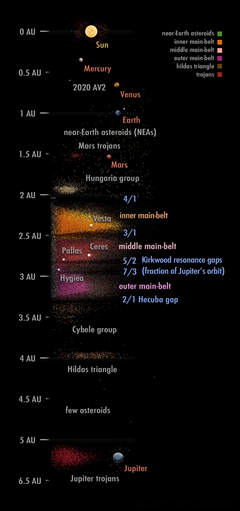
In 1918, the Japanese astronomer Kiyotsugu Hirayama noticed that the orbits of some of the asteroids had similar parameters, forming families or groups.[94]
Approximately one-third of the asteroids in the asteroid belt are members of an asteroid family. These share similar
Some of the most prominent families in the asteroid belt (in order of increasing semi-major axes) are the Flora, Eunomia, Koronis, Eos, and Themis families.[76] The Flora family, one of the largest with more than 800 known members, may have formed from a collision less than 1 billion years ago.[96] The largest asteroid to be a true member of a family is 4 Vesta. (This is in contrast to an interloper, in the case of Ceres with the Gefion family.) The Vesta family is believed to have formed as the result of a crater-forming impact on Vesta. Likewise, the HED meteorites may also have originated from Vesta as a result of this collision.[97]
Three prominent bands of dust have been found within the asteroid belt. These have similar orbital inclinations as the Eos, Koronis, and Themis asteroid families, and so are possibly associated with those groupings.[98]
The main belt evolution after the Late Heavy Bombardment was very likely affected by the passages of large Centaurs and trans-Neptunian objects (TNOs). Centaurs and TNOs that reach the inner Solar System can modify the orbits of main belt asteroids, though only if their mass is of the order of 10−9 M☉ for single encounters or, one order less in case of multiple close encounters. However, Centaurs and TNOs are unlikely to have significantly dispersed young asteroid families in the main belt, although they can have perturbed some old asteroid families. Current main belt asteroids that originated as Centaurs or trans-Neptunian objects may lie in the outer belt with short lifetime of less than 4 million years, most likely orbiting between 2.8 and 3.2 AU at larger eccentricities than typical of main belt asteroids.[99]
Periphery
Skirting the inner edge of the belt (ranging between 1.78 and 2.0 AU, with a mean semi-major axis of 1.9 AU) is the
Another high-inclination group in the inner part of the asteroid belt is the Phocaea family. These are composed primarily of S-type asteroids, whereas the neighboring Hungaria family includes some E-types.[100] The Phocaea family orbit between 2.25 and 2.5 AU from the Sun.[101]
Skirting the outer edge of the asteroid belt is the
New families
Some asteroid families have formed recently, in astronomical terms. The
More recently, the
Exploration
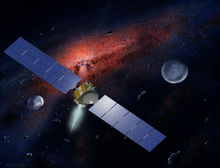
The first spacecraft to traverse the asteroid belt was
Most main belt asteroids imaged to date have come from brief flyby opportunities by probes headed for other targets. Only the Dawn mission has studied main belt asteroids for a protracted period in orbit. The Galileo spacecraft imaged 951 Gaspra in 1991 and 243 Ida in 1993, then NEAR imaged 253 Mathilde in 1997 and landed on near–Earth asteroid 433 Eros in February 2001. Cassini imaged 2685 Masursky in 2000, Stardust imaged 5535 Annefrank in 2002, New Horizons imaged 132524 APL in 2006, and Rosetta imaged 2867 Šteins in September 2008 and 21 Lutetia in July 2010. Dawn orbited Vesta between July 2011 and September 2012 and has orbited Ceres since March 2015.[111]
The Lucy space probe made a flyby of 152830 Dinkinesh in 2023, on its way to the Jupiter Trojans.[112] ESA's JUICE mission will pass through the asteroid belt twice, with a proposed flyby of the asteroid 223 Rosa in 2029.[113] The Psyche spacecraft is a NASA mission to the large M-type asteroid 16 Psyche.[114]
See also
References
- ^ Williams, Matt (August 23, 2015). "What is the Asteroid Belt?". Universe Today. Retrieved January 30, 2016.
- ^ S2CID 119404378.
- ^ .
- S2CID 120467483. Archived from the original(PDF) on July 3, 2014.
- ^ a b For recent estimates of the masses of Ceres, Vesta, Pallas and Hygiea, see the references in the infoboxes of their respective articles.
- ^ Yeomans, Donald K. (July 13, 2006). "JPL Small-Body Database Browser". NASA JPL. Archived from the original on September 29, 2010. Retrieved September 27, 2010.
- ^ Koberlein, Brian (March 12, 2014). "Why the Asteroid Belt Doesn't Threaten Spacecraft". Universe Today. Retrieved January 30, 2016.
- ^ a b "How Did The Asteroid Belt Form? Was There A Planet There?". CosmosUp. January 17, 2016. Archived from the original on December 6, 2018. Retrieved January 30, 2016.
- ^ Redd, Nola Taylor (June 11, 2012). "Asteroid Belt: Facts & Information". Space.com. Retrieved January 30, 2016.
- ^ Beatty, Kelly (March 10, 2009). "Sculpting the Asteroid Belt". Sky & Telescope. Retrieved April 30, 2014.
- Bibcode:1943JRASC..37..187D.
- S2CID 256570746.
- ^ Davis, Phil; Dunford, Bill; Boeck, Moore. "Dawn: Between Jupiter and Mars [sic], I Place a Planet" (PDF). Jet Propulsion Laboratory. NASA. Archived (PDF) from the original on November 21, 2005.
- ISBN 978-1-4614-4902-7.
- ^ a b c Hilton, J. (2001). "When Did the Asteroids Become Minor Planets?". US Naval Observatory (USNO). Archived from the original on April 6, 2012. Retrieved October 1, 2007.
- ^ a b "Dawn: A Journey to the Beginning of the Solar System". Space Physics Center: UCLA. 2005. Archived from the original on May 24, 2012. Retrieved November 3, 2007.
- ^ Hoskin, Michael. "Bode's Law and the Discovery of Ceres". Churchill College, Cambridge. Archived from the original on May 10, 2008. Retrieved July 12, 2010.
{{cite web}}: CS1 maint: bot: original URL status unknown (link) - ISBN 978-1-4831-5936-2.
- ^ "Call the police! The story behind the discovery of the asteroids". Astronomy Now (June 2007): 60–61.
- ^ Winterburn, Emily (March 10, 2021). "Discovering asteroid Vesta: the story of the Celestial Police". Sky at Night Magazine. BBC. Retrieved October 18, 2022.
- ^ McWilliams, Brendan (July 31, 2001). "Fruitless search of the Celestial Police". Irish Times. Retrieved October 18, 2022.
- ^ a b c Staff (2002). "Astronomical Serendipity". NASA JPL. Archived from the original on February 6, 2012. Retrieved April 20, 2007.
- ^ Harper, Douglas (2010). "Asteroid". Online Etymology Dictionary. Etymology Online. Retrieved April 15, 2011.
- ^ DeForest, Jessica (2000). "Greek and Latin Roots". Michigan State University. Archived from the original on August 12, 2007. Retrieved July 25, 2007.
- Bibcode:1984MPBu...11....3C.
- OCLC 1054369860.[page needed]
- ^ "Is it a coincidence that most of the planets fall within the Titius-Bode law's boundaries?". astronomy.com. Retrieved January 22, 2014.
- ISBN 978-0-8018-5503-0.
- ^ Mann, Robert James (1852). A Guide to the Knowledge of the Heavens. Jarrold. p. 171. and 1853, p. 216
- ^ "Further Investigation relative to the form, the magnitude, the mass, and the orbit of the Asteroid Planets". The Edinburgh New Philosophical Journal. 5: 191. January–April 1857.: "[Professor Peirce] then observed that the analogy between the ring of Saturn and the belt of the asteroids was worthy of notice."
- ^ Hughes, David W. (2007). "A Brief History of Asteroid Spotting". BBC. Archived from the original on June 11, 2011. Retrieved April 20, 2007.
- ISBN 978-0-521-89935-2.
- ^ Manley, Scott (August 25, 2010). Asteroid Discovery from 1980 to 2010. YouTube. Archived from the original on October 30, 2021. Retrieved April 15, 2011.
- ^ "MPC Archive Statistics". IAU Minor Planet Center. Retrieved April 4, 2011.
- S2CID 4448395.
- ^ a b Harrington, J. D. (January 22, 2014). "Herschel Telescope Detects Water on Dwarf Planet – Release 14-021". NASA. Retrieved January 22, 2014.
- ^ "A Brief History of Asteroid Spotting". Open2.net. Archived from the original on June 11, 2011. Retrieved May 15, 2007.
- ^ Bronshten, V. A. (1972). "Origin of the Asteroids". NASA.
- ^ Masetti, M.; Mukai, K. (December 1, 2005). "Origin of the Asteroid Belt". NASA Goddard Spaceflight Center. Retrieved April 25, 2007.
- ^ Watanabe, Susan (July 20, 2001). "Mysteries of the Solar Nebula". NASA. Archived from the original on January 17, 2012. Retrieved April 2, 2007.
- .
- ^ (PDF) from the original on February 21, 2007. Retrieved March 22, 2007.
- Bibcode:2006LPI....37.2367S.
- S2CID 18355985.
- .
- ^ Kelly, Karen (2007). "U of T researchers discover clues to early solar system". University of Toronto. Archived from the original on February 29, 2012. Retrieved July 12, 2010.
- doi:10.2307/j.ctv1v7zdn4.44.)
{{cite book}}: CS1 maint: location missing publisher (link - ISSN 0019-1035.
- ^ Keil, K. (2000). "Thermal alteration of asteroids: evidence from meteorites". Planetary and Space Science. Retrieved November 8, 2007.
- Bibcode:2003EAEJA.....7709B.
- .
- ^ Kracher, A. (2005). "Asteroid 433 Eros and partially differentiated planetesimals: bulk depletion versus surface depletion of sulfur" (PDF). Ames Laboratory. Archived (PDF) from the original on November 28, 2007. Retrieved November 8, 2007.
- ^ Piccioni, Robert (November 19, 2012). "Did Asteroid Impacts Make Earth Habitable?". Guidetothecosmos.com. Retrieved May 3, 2013.
- ^ Stiles, Lori (September 15, 2005). "Asteroids Caused the Early Inner Solar System Cataclysm". UANews. Retrieved October 18, 2018.
- ^ Alfvén, H.; Arrhenius, G. (1976). "The Small Bodies". SP-345 Evolution of the Solar System. NASA. Archived from the original on May 13, 2007. Retrieved April 12, 2007.
- ^ Bibcode:1990JRASC..84..123S.
- S2CID 18778001.
- ^ Berardelli, Phil (March 23, 2006). "Main-Belt Comets May Have Been Source Of Earths Water". Space Daily. Retrieved October 27, 2007.
- ^ Lakdawalla, Emily (April 28, 2006). "Discovery of a Whole New Type of Comet". The Planetary Society. Archived from the original on May 1, 2007. Retrieved April 20, 2007.
- .
- . Retrieved February 11, 2023.
- ^ Yeomans, Donald K. (April 26, 2007). "JPL Small-Body Database Search Engine". NASA JPL. Retrieved April 26, 2007. – search for asteroids in the main belt regions with a diameter >100.
- doi:10.1086/339482.
- .
- S2CID 121856071.
- ^ a b Williams, Gareth (September 25, 2010). "Distribution of the Minor Planets". Minor Planets Center. Retrieved October 27, 2010.
- ^ "The asteroid belt contains solar system remnants". EarthSky | Updates on your cosmos and world. November 3, 2021. Retrieved January 20, 2023.
- ^ Williams, Matt (August 10, 2016). "How Far is the Asteroid Belt from Earth?". Universe Today. Retrieved January 20, 2023.
- ^ "In Depth | Ceres". NASA Solar System Exploration. Retrieved February 11, 2023.
- S2CID 32447726.
- ^ S2CID 4648806.
- ^ (PDF) from the original on July 6, 2011. Retrieved September 6, 2008.
- ^ ISBN 978-1-59033-482-9.
- Bibcode:1996LPI....27..225C.
- S2CID 5479442. Archived from the original(PDF) on February 26, 2020.
- ^ a b Lang, Kenneth R. (2003). "Asteroids and meteorites". NASA's Cosmos. Archived from the original on March 24, 2012. Retrieved April 2, 2007.
- Bibcode:2005DPS....37.0702M.
- ^ Bibcode:2008LPICo1405.8154D.
- ^ a b Than, Ker (2007). "Strange Asteroids Baffle Scientists". space.com. Retrieved October 14, 2007.
- ^ "When is a comet not a comet?". ESA/Hubble Press Release. Retrieved November 12, 2013.
- doi:10.1086/184213.
- ^ "Interview with David Jewitt". YouTube.com. January 5, 2007. Archived from the original on October 30, 2021. Retrieved May 21, 2011.
- ^ This value was obtained by a simple count of all bodies in that region using data for 120,437 numbered minor planets from the Minor Planet Center orbit database, dated February 8, 2006.
- ^ "JPL Small-Body Database Search Engine: orbital class (MBA)". JPL Solar System Dynamics. Retrieved February 26, 2018.
- doi:10.1511/1999.5.398. Archived from the originalon June 21, 2017. Retrieved February 4, 2007.
- S2CID 33032137.
- ^ Backman, D. E. (March 6, 1998). "Fluctuations in the General Zodiacal Cloud Density". Backman Report. NASA Ames Research Center. Archived from the original on March 3, 2012. Retrieved April 4, 2007.
- (PDF) from the original on August 7, 2004.
- S2CID 119530506.
- ^ doi:10.1086/171428.
- S2CID 18865066.
- ^ Kingsley, Danny (May 1, 2003). "Mysterious meteorite dust mismatch solved". ABC Science. Retrieved April 4, 2007.
- ^ "Meteors and Meteorites" (PDF). NASA. Archived from the original (PDF) on October 15, 2006. Retrieved January 12, 2012.
- ^ Hughes, David W. (2007). "Finding Asteroids In Space". BBC. Archived from the original on March 10, 2012. Retrieved April 20, 2007.
- .
- ^ Martel, Linda M. V. (March 9, 2004). "Tiny Traces of a Big Asteroid Breakup". Planetary Science Research Discoveries. Archived from the original on April 1, 2007. Retrieved April 2, 2007.
- .
- doi:10.1086/116399.
- S2CID 118898917.
- .
- S2CID 96428710.)
{{cite journal}}: CS1 maint: multiple names: authors list (link - ISBN 978-1-4419-6438-0. Retrieved April 4, 2011.
- .
- ^ McKee, Maggie (January 18, 2006). "Eon of dust storms traced to asteroid smash". New Scientist Space. Retrieved April 15, 2007.
- (PDF) from the original on May 9, 2008.
- .
- S2CID 1747264. Archived from the original(PDF) on April 12, 2020.
- S2CID 118554353. 77.
- ^ Greicius, Tony (July 31, 2015). "NASA's Juno Gives Starship-Like View of Earth Flyby". nasa.gov. NASA. Retrieved September 4, 2015.
- ^ Stern, Alan (June 2, 2006). "New Horizons Crosses The Asteroid Belt". Space Daily. Retrieved April 14, 2007.
- S2CID 123088075.
- ^ "NASA's Lucy Team Announces New Asteroid Target". NASA. January 25, 2023. Retrieved February 14, 2023.
- S2CID 244753425.
- ^ "NASA Continues Psyche Asteroid Mission". NASA. October 28, 2022. Retrieved February 14, 2023.
External links
- Arnett, William A. (February 26, 2006). "Asteroids". The Nine Planets. Archived from the original on April 18, 2007. Retrieved April 20, 2007.
- Asteroids Page at NASA's Solar System Exploration
- Cain, Fraser. "The Asteroid Belt". Universe Today. Archived from the original on March 7, 2008. Retrieved April 1, 2008.
- "Main Asteroid Belt". Sol Company. Archived from the original on May 15, 2007. Retrieved April 20, 2007.
- Munsell, Kirk (September 16, 2005). "Asteroids: Overview". NASA's Solar System Exploration. Archived from the original on May 24, 2007. Retrieved May 26, 2007.
- Plots of eccentricity vs. semi-major axis and inclination vs. semi-major axis at Asteroid Dynamic Site
- Staff (October 31, 2006). "Asteroids". NASA. Archived from the original on April 11, 2007. Retrieved April 20, 2007.
- Staff (2007). "Space Topics: Asteroids and Comets". The Planetary Society. Archived from the original on April 28, 2007. Retrieved April 20, 2007.







